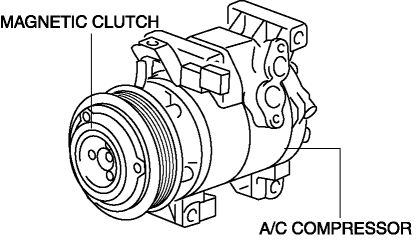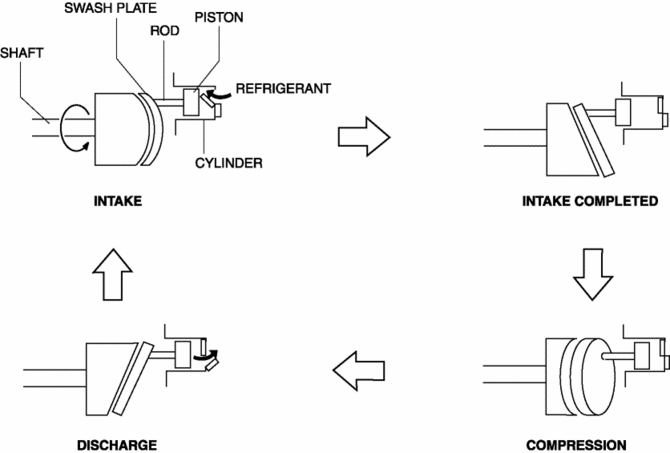Mazda CX-5 Service & Repair Manual: A/C Compressor
Purpose
-
The A/C compressor circulates the refrigerant in the refrigerant cycle.
-
The A/C compressor compresses the gaseous refrigerant atomized by the evaporator, and by pressurizing the gaseous refrigerant, liquification by the condenser is facilitated.
Function
-
The A/C compressor compresses the gaseous refrigerant by driving the piston in the compressor using the drive force from the engine. In addition, it sends the compressed refrigerant to the condenser.
Construction
-
The A/C compressor has adopted a swash plate type compressor.
-
The A/C compressor consists of the following parts:

-
Shaft
-
Swash plate
-
Cylinder
-
Piston
Operation
-
When the drive force from the engine is transmitted to the compressor shaft by the operation of the magnetic clutch, the A/C compressor rotates the swash plate in the compressor. The rotation of the swash plate generates compression in the cylinder by the reciprocating movement of the piston.
1. When the piston moves downward, the suction valve opens and the refrigerant is discharged to the cylinder.
2. When the piston reaches the BDC, refrigerant charging is completed and the suction valve is closed.
3. When the piston moves upward, the refrigerant in the cylinder is compressed.
4. The compressed refrigerant presses open the discharge valve, and the high-temperature, highly pressurized refrigerant from the cylinder is discharged.

Fail-safe
-
Function not equipped.
 A/C
A/C
...
 A/C Compressor Control [Full Auto Air Conditioner]
A/C Compressor Control [Full Auto Air Conditioner]
Purpose
The A/C compressor control switches the A/C compressor on/off according to
the vehicle environment.
Function
The A/C compressor control turns the A/C compressor on/off b ...
Other materials:
Canister Vent (Cv) Solenoid Valve
U.S.A. And CANADA
Purpose, function
Seals the atmosphere side of the charcoal canister during EVAP leak check
monitoring.
Construction
Included in the charcoal canister.
The CV solenoid valve is consists of O-rings.
Operation
According to the ...
Headlight High Beam Indicator Light
Purpose
Notifies the user that the headlights (HI) are illuminated.
Function
Illuminates when the headlight (HI) or parking illumination conditions are
met.
Construction
Displayed in the instrument cluster.
Operation
1. When the light switch is operat ...
Rear Wiper Arm And Blade Removal/Installation
Rear Wiper Arm
1. Pull the cap in the direction of the arrows (1) shown in the figure and remove
it in the direction of the arrow (2) with tabs A, B released.
2. Remove the nut with the rear wiper arm and blade pressed.
3. Raise the rear wiper arm and detach it from the serrated conne ...
